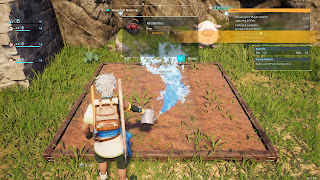Palworld is a survival game, and survival demands fulfilling needs. One of the more pressing needs in Palworld is food. Both your player and ther partner Pals need food, and while you can go looking for it in the wild, this takes a lot of time and energy. A better option is to start your own little farm.
This guide will help you begin your own little farm in Palworld. Since 'farming' in video games can mean a whole bunch of different things - farming for a specific, non-edible resource, for example - we'll get very specific: In this guide we're going to help you set up your first Berry Plantation. Let's get to it.
Step 1: Build the Berry Plantation
You won't get very far in food generation without a place to grow the food - in this case, Red Berries. We'll start by creating a Berry Plantation. These are Technology level 5 structures, and have the following cost:
- 3 Berry Seeds, from collecting Red Berries in the wild
- 20 Wood, from cuttng down trees
- 20 Stone, from picking at heaps of rocks
You can put the Berry Plantation anywhere you like in your base, though for efficiency's sake you may want to set it in a bit of a clearing, in case you want to create nearby, additional Berry Plantations in the future.
Once you've set up the Berry Plantation you won't need to add any more seeds. It's good to go. You will, however, have to perform some back-breaking labor to generate food.
Step 2: Work the Berry Plantation
Next up is actually generating the Red Berries. When you're just starting out you'll probably only have one or two Pals in your base, and the chances are good that they won't be great at this aspect of farming. You can handle the food generation yourself, fortunately - it's just a bit boring.
Stand in front of the Berry Plantation and press the X button / F key. This begins the work phase. Hold the button down during each phase until it ends. There are four phases to a Berry Plantation's growth cycle:
- Seeding / Planting
- Watering
- Growing
- Gathering / Transporting
Growing is the only phase where you don't need to do anything besides wait. For the rest you'll need to hold down the X button / F key and wait for the work to get done. By the end you'll have a few Red Berries to eat. This is the boring way to handle farming, of course, so we'll let someone else handle it.
Step 3: Make Your Pals Farm
Whenever you assign a Pal to a base it will actively look for a job to do, assuming it's well-fed and in a good mood. As soon as something opens up that the Pal can handle, it will rush over and do the job for you. The types of jobs the Pal can handle are found under the Work Suitability menu, available under each Pal's profile when you inspect them via the Palbox.
To fully automate a Berry Plantation you'll need potentially three different types of Pals to handle the various steps:
- A Gumoss can handle the Planting - You'll find them near the game's second Fast Travel point, a ways down the rocky terrain from your starting location
- A Pengullet can handle the Watering - You'll find Pengullets along the cliffs leading to the second Fast Travel point, usually near the streams and rivers that run through the area (be ready for a chase, they tend to run away when approached)
- A number of different starting Pals can handle the Transporting - One Pal you're likely to have early on is Cattiva, which explore the grassy sections below, and adjcent to, your starting area
Each Pal should, if the game is functioning properly, handle each of the four steps required to make your Berry Plantation productive. You can then ignore the Berry Plantation completely, and as long as you have a Feed Box set up your Pals will handle their own nourishment.
It's worth noting that these steps apply to every work station that you can build in Palworld. Some, like the Berry Plantation, have multiple steps, and once you know which Work Suitability trait fulfills each step you can deploy the appropriate Pals to handle the process.



